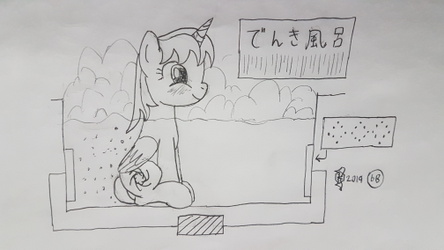Sign In
ClosePTSJ19 Day 7: Kumamoto to Nagasaki by Parcly Taxel
Parcly Taxel: In Kikuchi I bathed in an "electric onsen" that replaced water jets with short pulses of electrons. This brings me to the interesting story of the national grid of Japan, which is split between 60 Hz west of Tokyo and 50 Hz everywhere else. This difference arose from the operating regions of companies that first brought electricity to Japan and can cause problems for some travellers who bring only one adapter. However, since we were only exploring the western side this time, this was not a problem.
Spindle: The elderly couple prepared breakfast for us, consisting of mackerel, radish, breaded pollock and more with rice. It was not too filling of a meal since we were heading out later.
We took our time to pack up our luggage – our hosts were quite popular among travellers despite residing in the "middle of nowhere", and we had woken up very early for the aforementioned breakfast. Indeed, a previous guest, a mare, had rode a bicycle here from the nearest train station (and Parcly didn't know where that was). Desserts of pudding and persimmon were also provided.
Parcly: Agriculture is a very important economic activity in this part of Japan. We had seen it in the crop fields near Nishi-Ōyama, the cow pasture at the lookout point for Nakadake and persimmon gardens cultivated by those old ponies. A good proportion of rural workers are members of JA, the union of agricultural co-operatives, which provides them with much more than just distribution services; the Cocco Farm local market, which we visited for some tidbits, is one of the "extra services" JA's support enables.
Rainbow Dash: On the way down to Kirishima Parcly and Spindle took the tolled Kyushu Expressway, needing to rush to the next accommodation before total nightfall. On the first part of her way up, and to western Kyushu after her time down the eastern shore and central volcanic ranges, she didn't need to pay a single yen.
The high-level road network in Japan comprises expressways, which are always tolled, and national highways which are not. The latter category often blends in with local roads so effectively that you might not realise you are on a special road unless you were paying attention to signs.
Spindle: Arriving in Kumamoto (熊本), our first stop was its castle, considered one of Japan's three greatest castles alongside Himeji and Matsumoto. Yet stone piles and collapsed roofs abounded in the complex, because three and a half years ago an earthquake dealt serious damage to its outer buildings and walls, the main keep suffering less damage. Restoration work was expected to continue for another 15 years.
Rainbow: An exterior path around the castle keep was open for sightseeing, but mostly only on Sundays. The two windigos found ponies from many lands discussing the castle, the earthquake and its aftermath, indicating the site's continuing allure after suffering.
Parcly: Kumamoto is quite a large city, so I walked around the Sakuranobaba Jōsaien (桜の馬場 城彩苑) "souvenir alley" and the nearby shopping centre Sakuramachi Kumamoto. Lunch slipped away from my mind, aided by both a large breakfast and minor intrigues dotting the cityscape. It was past 4pm when our hearts were no longer craving for more.
Spindle: Our overall strategy for any trip in a large country since South Korea has been to start from a rural or faraway place and work "inwards" to the cosmopolitan cities – rural first, because more of the country's history is exposed there; urban later, to lessen cultural shock upon returning home. This city, whose black bear mascot is perhaps the most famous of all location mascots, marked the rural-to-urban transition for this trip, a prelude to the madness of Osaka.
Parcly: Sooner or later my body had to crave something; Spindle whinnied her need for emotions. We ended up eating lunch and dinner combined at Katsuretsu Tei in Kumamoto, their seasonal special dish of fried oysters and prawns. I thought I packed enough space, but after my plate was emptied of cabbage, sauces and "meats" my stomach sank.
I still had a long way to Nagasaki overland, curving around the expressway of the same name and the Ariake Sea (有明海) – the direct route would involve flying over a strait and I doubted my wings were healthy enough to carry my newly acquired load across. I could also digest my food faster by just galloping, while a rest area gave me adequate time to nudge it back into a comfortable arrangement.
Spindle: Nagasaki greeted us with speckled lights high and low, including some that in the black (not very light-polluted) sky suggested the presence of a large plaza for pegasi (it was really a broadcasting station on a hilltop). Ascending a steep slope brought us to our next accommodation, the Baishokaku (梅松鶴). It was very luxurious, with every room having a name; ours was Nagetaki (鳴滝). The hotel staff even laid out futons right in front of us.
Parcly: Closing out the day was a soak in the hotel's private onsen. By this time my dinner was completely digested, and I had pretty much the whole bath area to myself because it was a Sunday. I retreated to my room, looking forward to trekking across this city at the western edge of Japan with a deep, deep history.
Submission Information
- Views:
- 265
- Comments:
- 0
- Favorites:
- 0
- Rating:
- General
- Category:
- Visual / Traditional




